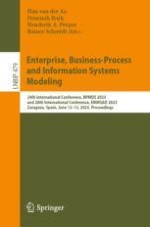This book contains the refereed proceedings of two long-running events held along with the CAiSE conference relating to the areas of enterprise, business-process and information systems modeling:
* the 24th International Conference on Business Process Modeling, Development and Support, BPMDS 2023, and
* the 28th International Conference on Exploring Modeling Methods for Systems Analysis and Development, EMMSAD 2023.
The conferences were taking place in Zaragoza, Spain, during June 12-13, 2023.
For BPMDS 9 full papers and 2 short papers were carefully reviewed and selected for publication from a total of 26 submissions; for EMMSAD 9 full papers and 3 short papers were accepted from 26 submissions after thorough reviews.
The BPMDS papers deal with a broad range of theoretical and applications-based research in business process modeling, development and support. EMMSAD focusses on modeling methods for systems analysis and development.
